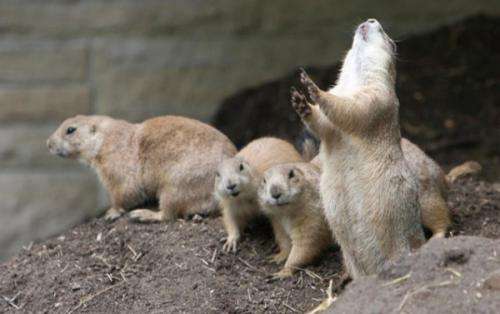January 8, 2014 report
Researchers suggest prairie dog jump-yips are means to assess group alertness (w/ Video)

(Phys.org) —A trio of researchers from the University of Manitoba has concluded that the action known as a jump-yip, performed by some species of prairie dogs, is done more to assess group alertness than to sound the all-clear as has been previously suggested. In their paper published in Proceedings of the Royal Society B: Biological Sciences, James Hare, Kevin Campbell and Robert Senkiw describe a field study they conducted among prairie dogs and the conclusions reached as a result.
Two species of prairie dogs, black-tailed prairie dogs and Mexican prairie dogs, exhibit a behavior that has fascinated biologists for centuries. One will stand up, seemingly without reason, on its haunches, lean back its head and call out "wee-oo." Immediately thereafter, the other prairie dogs in the vicinity will do the same in wave fashion, similar to that seen by humans at sporting events.
Over the years, many have offered suggestions as to why the prairie dogs jump-yip, with most concluding that it was likely a way for individual members to tell others that danger has passed. In this new effort, the researchers not only debunk that theory, but offer a more promising alternative instead.
To find out what's really going on with the prairie dogs, the researchers ventured to North and South Dakota and Manitoba to watch and video record prairie dogs in their native environment (prairie dog towns) over the course of two years. What they witnessed convinced them that the jump-yip is not an all-clear sign—they do it before, during and after dangerous events. Instead, the researchers noted that sometimes jump-yipping resulted in strong wave action and sometimes the response was weaker—when it was stronger the original jump-yipper foraged strongly afterwards, seemingly without a care in the world—when the wave response was weak, however, the instigator foraged more slowly and carefully. This behavior led the researchers to conclude that the whole point of jump-yipping is for one prairie dog to assess the alertness and responsiveness of his or her associates. If others are highly alert, it means it's safer to forage—if not, more care should be taken.
More information: Catch the wave: prairie dogs assess neighbours' awareness using contagious displays, Published 8 January 2014 DOI: 10.1098/rspb.2013.2153
Abstract
The jump–yip display of black-tailed prairie dogs (Cynomys ludovicianus) is contagious, spreading through a prairie dog town as 'the wave' through a stadium. Because contagious communication in primates serves to assess conspecific social awareness, we investigated whether instigators of jump–yip bouts adjusted their behaviour relative to the response of conspecifics recruited to display bouts. Increased responsiveness of neighbouring town members resulted in bout initiators devoting a significantly greater proportion of time to active foraging. Contagious jump–yips thus function to assess neighbours' alertness, soliciting social information to assess effective conspecific group size in real time and reveal active probing of conspecific awareness consistent with theory of mind in these group-living rodents.
Journal information: Proceedings of the Royal Society B
© 2014 Phys.org


















